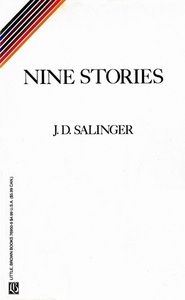You need to sign in or sign up before continuing.
Take a photo of a barcode or cover
These nine stories appear to be written during the 40's and 50's and it seems Salinger spent some time studying people, how they thought and what they did. All the stories are different and a couple of them I thought would make excellent script for The Twilight Zone. The only common thing I noticed was in each story it appears that smoking was the fashion as at least one character lit up, that's something to be remembered when the modern day authors write stories reflecting this era...remember at least one character needs to smoke. I think this work would fit quite well with my recent Great Courses: The Dark Side of Human Nature so if you per chance have read that book first these stories would really fall under examples of Human Nature because that's for the most part exactly what they are. The soldier before and after the war, some developed what was termed “shell shock”, now it's labeled PTSD but how could every soldier who lived through the horror of war process their experiences the same way. I do recommend this work by Salinger especially if you were able to appreciate The Catcher in the Rye.
emotional
reflective
medium-paced
Plot or Character Driven:
Character
Diverse cast of characters:
No
"Nine Stories" is a book to revisit at various junctures in one's life, as each reading can reveal something new. I intend to revisit it at different stages of my lifetime. One's sentiments toward these stories are likely to shift depending on the circumstances they are experiencing.
Genius.
"The Catcher in the Rye" has always held a special place in my heart for both positive and negative reasons. However, I now comprehend why I hold such an affection for Salinger's narratives and writing. It is because of their inherent paradoxes. The power of his “Nine Stories” becomes evident when examined and read collectively, as they are a collection of paradoxes. At first glance, they may appear strange and humorous, but upon closer inspection, they reveal insecurities and heartbreak. This is what makes these stories so genuine.
Much like "The Catcher in the Rye," Salinger's “Nine Stories” celebrate the uniqueness, eccentricity, and preciousness of each individual. As always, Salinger takes the daring path of risking being misunderstood, which is a courageous choice in the realm of writing. This is why delving deeper into his work is essential.
As of today, my top three preferences are as follows:
1. Teddy
2. For Esmé—with Love and Squalor
3. A Perfect Day for Bananafish.
"De Daumier-Smith’s Blue Period" holds a special place as well. The narrator reflects on their dreadful younger self, narcissistic and miserable, while teaching a correspondence art class in Montreal, specifically at "Les Amis des Vieux Maîtres" in Verdun, a "rundown section" of the city. It is a tale of profound loneliness that managed to evoke laughter, a feat that appeared challenging. Cette histoire ferait écho à n'importe quel montréalais(e) comme moi.
“The fact is always obvious much too late, but the most singular difference between happiness and joy is that happiness is a solid and joy a liquid.” ― J.D. Salinger, 'De Daumier-Smith’s Blue Period' of Nine Stories.
I must also mention "The Laughing Man," which was published in the 1949 New Yorker. The title actually refers to the story within the story, where the nameless narrator, ostensibly Salinger, recounts an adventure at the age of nine when he and other members of his Comanche club were entertained by a Staten Island law student nicknamed Chief, who was paid to keep them engaged. The structure of the story may be somewhat melodramatic and formulaic, even for that era, but there are moments when one can credit Salinger for attempting to break free from the confines of traditional storytelling.
*
“Our parents don't seem able to love us just the way we are. They don't seem able to love us unless they can keep changing us a little bit. They love their reasons for loving us almost as much as they love us, and most of the time more.” ― J.D. Salinger, 'Teddy' of Nine Stories.
Genius.
"The Catcher in the Rye" has always held a special place in my heart for both positive and negative reasons. However, I now comprehend why I hold such an affection for Salinger's narratives and writing. It is because of their inherent paradoxes. The power of his “Nine Stories” becomes evident when examined and read collectively, as they are a collection of paradoxes. At first glance, they may appear strange and humorous, but upon closer inspection, they reveal insecurities and heartbreak. This is what makes these stories so genuine.
Much like "The Catcher in the Rye," Salinger's “Nine Stories” celebrate the uniqueness, eccentricity, and preciousness of each individual. As always, Salinger takes the daring path of risking being misunderstood, which is a courageous choice in the realm of writing. This is why delving deeper into his work is essential.
As of today, my top three preferences are as follows:
1. Teddy
2. For Esmé—with Love and Squalor
3. A Perfect Day for Bananafish.
"De Daumier-Smith’s Blue Period" holds a special place as well. The narrator reflects on their dreadful younger self, narcissistic and miserable, while teaching a correspondence art class in Montreal, specifically at "Les Amis des Vieux Maîtres" in Verdun, a "rundown section" of the city. It is a tale of profound loneliness that managed to evoke laughter, a feat that appeared challenging. Cette histoire ferait écho à n'importe quel montréalais(e) comme moi.
“The fact is always obvious much too late, but the most singular difference between happiness and joy is that happiness is a solid and joy a liquid.” ― J.D. Salinger, 'De Daumier-Smith’s Blue Period' of Nine Stories.
I must also mention "The Laughing Man," which was published in the 1949 New Yorker. The title actually refers to the story within the story, where the nameless narrator, ostensibly Salinger, recounts an adventure at the age of nine when he and other members of his Comanche club were entertained by a Staten Island law student nicknamed Chief, who was paid to keep them engaged. The structure of the story may be somewhat melodramatic and formulaic, even for that era, but there are moments when one can credit Salinger for attempting to break free from the confines of traditional storytelling.
*
“Our parents don't seem able to love us just the way we are. They don't seem able to love us unless they can keep changing us a little bit. They love their reasons for loving us almost as much as they love us, and most of the time more.” ― J.D. Salinger, 'Teddy' of Nine Stories.
A little dated in zeitgeist, but aptly told nonetheless.
dark
emotional
reflective
sad
medium-paced
Plot or Character Driven:
Character
Strong character development:
Yes
Loveable characters:
Complicated
Diverse cast of characters:
Yes
Flaws of characters a main focus:
Complicated
emotional
funny
reflective
medium-paced
I’ll never be able to stop thinking about this book
Oh, how I love thee, Salinger. He is a master of human relationships and character building. His stories are always so charming, deeply personal, and real. If only he wrote more than just four novels.




